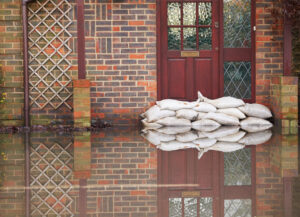The weather is becoming increasingly less predictable and we can gravitate from bright sunshine to a major thunderstorm in minutes. With this unpredictability comes the increased likelihood of flash floods and it is not just properties in known flood plains that are affected by flooding as drainage channels can get blocked or overwhelmed really quickly leading to localised flooding. In this article we cover some sage advice and tips about protecting your home from flooding.

Check the risk
Some properties are in known flood risk areas and it is always good to check this as part of the buying process. At least if you know about it you can prepare for it. The Government has two services to help you understand the long term flood risk in an area and any flash flooding risk.
Preventative measures
There is plenty that can be done, even in higher risk flood areas to prevent your property from flooding:
- Use permeable paving surfaces so that any water can naturally soak away rather than accumulating
- Install water resistant windows, doors and airbricks. This might not be too economical, but is a lot cheaper than having to remediate after a flood
- Install non-return valves on toilets and sewers to prevent any water or sewerage backing up back into the property.
- Ensure that all drains to a property are well maintained and kept clear through regular inspections and maintenance. This will ensure that any water can drain away quickly and readily.
- For particularly high-risk areas install permanent flood gates to divert water away from your property. Where the likelihood is less, then install removable door and widow barriers
- Stock up on sand bags or equivalent to be used in the event of a sudden flood.
- Ensure all gutters are kept clean and clear from debris to allow water run off from roofs to go to drain rather than overflow
- Sign up for flood warnings on the Government website so that you are aware ahead of time if there is a risk.
There are also some ways to mitigate potential damage if your property is flooded:
- Raise all electrical sockets to at least 1.5m from the floor, this will help to minimise electrical damage
- Only install hard flooring such as stone or ceramic tiles downstairs rather than carpets or laminate.
- Install waterproof skirting boards and use a waterproof wall sealant internally.
- Raise all electrical equipment up to higher levels or mount on the wall.
You might also want to consider investing in suitable insurance cover to insure your home against flooding, although this won’t prevent damage, it will ensure that the financial stress if there is a flood in your home is kept to a minimum.






